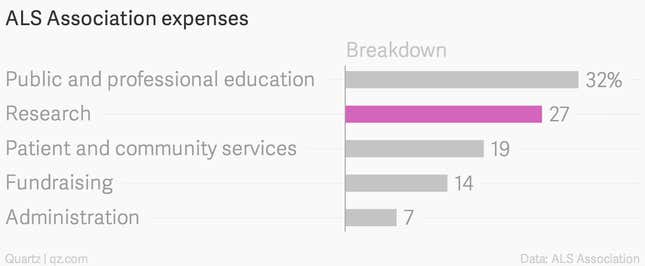The news that ALS Association (ALSA), which has reportedly raised almost $90 million through the viral “ice bucket challenge,” only spends 27% of its money in actual research is generating outrage.

Critics say this is far too small a proportion, and some are quoting Christian charity watchdog ECFA’s standard of efficiency which states 80% of funds should go to the cause that any nonprofit advocates.
But while ASLA’s breakdown says that less than 30% goes to research, the association’s mission statement is broader:
“The mission of The ALS Association is to lead the fight to treat and cure ALS through global research and nationwide advocacy, while also empowering people with Lou Gehrig’s Disease and their families to live fuller lives by providing them with compassionate care and support.”
It’s arguably fair, then, to add the 32% that goes to “public and professional education” and the 19% to “patient and community services” to the tally of funds spent in pursuit of the association’s mission. That adds up to 79%.
In fact, according to charity evaluator Charity Navigator, ALSA’s overall rating is 90.73/100, with a financial score of 87.24/100.
By comparison, the Multiple Sclerosis Association of America (MSAA), with a cause not unlike ALSA’s, gets a score of 81.79/100 (financial score: 74.43/100) and devotes 66% of its funds to program-related activities.

Komen, a charity that addresses breast cancer, spends 82.9% of its budget on the program, yet its overall rating is 81.96/100 (financial score: 74.67/100).

Aside from the outcry about the 27% spent on research, ALSA has raised concerns because of the high salaries of its top executives. But they are well within the range of nonprofit salaries; the compensation for ALSA’s CEO compares favorably with that of his peers, including some who run low-performing nonprofits:

The debate on whether people working in charities should be well paid is an old one, and it’s far from being resolved. But if anything, the interest that ALSA’s financials have generated supports the argument that one should look into a charity’s reputation and reliability before—and not after—donating on a social media whim.
